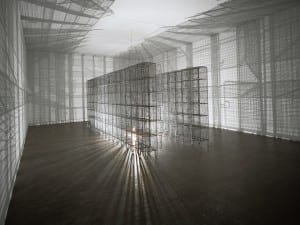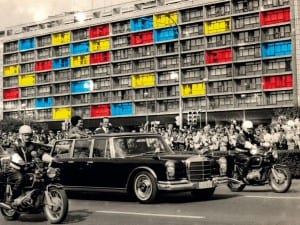A new sculptural project at Attingham Park that looks at the fragile relationship between the environment and Man, tackling some of today’s largest global concerns through a large–scale outdoor installation.
Inspired by The Rolling Stones’ song of the same name, Give Me Shelter is a new exhibition that explores Man’s changing relationship with the natural environment through new sculptural work and installations located in the grounds of the National Trust’s grand 18th century mansion, Attingham Park.
This exhibition demonstrates an emerging theme preoccupying the art world — the exploration of the individual within the natural environment. Artists around the globe are creating new works that reflect this precarious relationship. The artists showing their work at Give Me Shelter asked quintessential questions, and approached the idea of shelter and the environment in very different ways. A simple walk through Attingham’s impressive grounds forms a tool for exploring the artists’ work in their organic element.
Ivan and Heather Morison’s How to Prosper in the Coming Bad Years is inspired by traditional pigeon rookeries found in rural Egypt and provides a nesting environment for Attingham’s bird life. The huge adobe sculpture is encircled by an enigmatic ring, which suggests a future in which Man and nature will need to find ways to coexist in a harmonious and mutually beneficial way. In this case, the sculpture provides shelter, and in return for this shelter, the birds provide their squab to fertilise the land on where food is cultivated.
Visitors inspecting Attingham’s enormous walled garden, which once provided food to support an extended household of hundreds of people, will stumble upon Cornford + Cross’s large globe of security wire, which is positioned over the location of an old artesian well. At the “heart” of the globe is a lethal tangle of razor wire. With The Once and Future King, Cornford + Cross take precautionary action to protect this fertile ground, which they suggest could become vital and contested territory as a result of impending shortages and scarcity of food and water.
A walk through the dense woodland near the stable blocks leads to a modest wooden hut, however this shelter is not all that it might seem. A cavity beneath it mirrors the space above but it holds darker associations – a cellar, a safe hiding place or perhaps a cell. Henry Krokatsis has utilised the bricked deep hollow that was once the stately home’s icehouse to create this upside-down space for The Double Hut. Although there is still an implicit sense of safety in this concealed space, it is one of safety from an imminent and ultimate threat but might also be a threat in itself.
A twenty-metre, sinuous steel walkway, entitled Roma stretches between the west wing of the mansion and the graceful curves of the river Tern. Keith Wilson’s work is a formal gesture and walk-through sculpture, which borrows the shape of a cattle run. The interior walls of the walkway are coated in a thick layer of high-density rubberised foam, finished in a luxuriant glossy blue, seemingly at odds with the harsh industrial materials used to construct the run. The work is named Roma since its curves echo those of the river Tiber, Italy’s third longest river, and that on which Rome was founded.
The title of Charlotte Gyllenhammar’s work, Traum, is German for “dream”, but its sound suggests other words like “room” or “trauma”. The simple and unsettling presentation of a delicate floating balloon imprisoned in a heavy and brutal tower evokes the complex psychological constructs involved in keeping one’s dreams and ideals alive.
At first glance, Susan Grant’s work looks like a wonderful scattering of red rose petals on the lake of Attingham’s Deer Park. On closer inspection, we see that these are miniature, Monopoly-like red houses floating on the water. Dispossession recalls the many settlements that have come and gone from the Attingham site, from prehistoric and Roman villages to the early 18th century, when an iron works was demolished and the iron workers’ village destroyed, and the WWII US Airforce base that included villages for the airmen and their families, which was razed to the ground in the 1970s.
Christina Mackie’s, The Large Huts, references displaced communities and contested territories, and was inspired, during an artist residency in Pakistan, by the sand-cast concrete sun shelters that punctuate the infamous Gadani Beach in Baluchistan. Once a popular tourist destination, the area has suffered the dramatic effects of the decline of the local ship-breaking industry. In this post-industrial landscape, at the heart of a troubled region populated by displaced communities and migrant workers, the elemental shapes of the shelters moved the artist to make small sculptures with grey clay from the Indus Valley.
Anne de Charmant, Director of Meadow Arts said: “The artists that Meadow Arts have invited to make new sculptural works for Give Me Shelter were presented with over 400 acres of some of the most beautiful landscape in the country to work with — that’s a lot of space and quite a challenge. Each has responded to the size of the site with equally big ideas about some of today’s most important global issues, from world food shortages to the future of man’s survival, while creating wonderful works that integrate with both the location and the history of Attingham Park.”
Give Me Shelter ran from 1 October 2008 to 27 September 2009 at Attingham Park, Shropshire.
Dee Sekar
Dee Sekar is Editor of Soma Soma Scene and musician with An Experiment On A Bird In The Air Pump.





